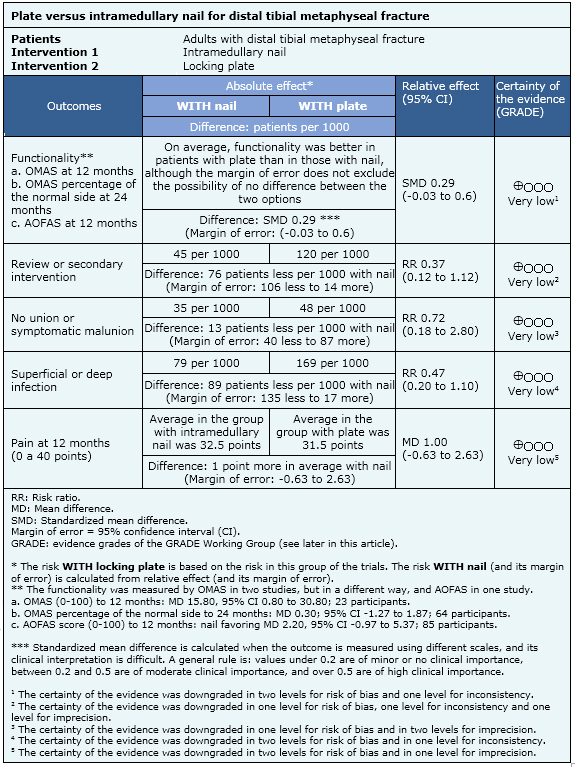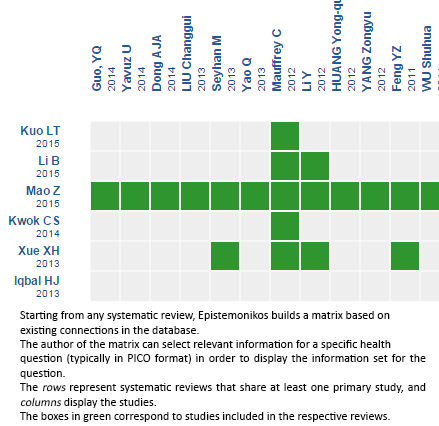Epistemonikos summaries
← vista completaPublished on November 7, 2015 | http://doi.org/10.5867/medwave.2015.6306
Is intramedullary nailing superior to plating in patients with extraarticular fracture of the distal tibia?
¿Es superior el clavo endomedular a la placa en pacientes con fractura de tibia distal extraarticular?
Abstract
Distal tibial metaphyseal fractures are generally produced by high-energy trauma such as car accidents and can cause severe disability due to pain and deformity. In the management of these fractures, there are multiple surgical alternatives, but it is uncertain which the best option is. Searching in Epistemonikos database, which is maintained by screening 30 databases, we identified six systematic reviews including three randomized trials. We combined the evidence using meta-analysis and generated a summary of findings table following the GRADE approach. We concluded it is not clear whether one surgical option is better than the other, because the certainty of the evidence is very low. Two ongoing randomized trials might help solving this uncertainty.
Problem
The distal tibial metaphysis is defined as a square construction in which the length of its sides equals the widest portion of the tibial plafond. Extraarticular fractures of the distal tibia (43A according to AO/OTA classification) have more soft tissue damage than diaphyseal fractures due to its relatively exposed position. Additionally, it is technically demanding to achieve an acceptable alignment for its proximity to the ankle joint. Intramedullary nailing is the treatment of choice for tibial diaphyseal fractures. Its advantages include the preservation of soft tissue and the possibility of early mobilization. However, the reduction of the fracture in the distal region may be difficult to maintain due to the size of the intramedullary canal at the metaphysis. Plate fixation could improve alignment but it is associated with a higher risk of surgical complications, such as infection, inadequate coverage of soft tissue, and vascular damage during surgery. Thus, there is uncertainty regarding the optimal surgical treatment for distal tibial metaphyseal fractures.
Methods
We used Epistemonikos database, which is maintained by screening more than 30 databases, to identify systematic reviews and their included primary studies. With this information, we generated a structured summary using a pre-established format, which includes key messages, a summary of the body of evidence (presented as an evidence matrix in Epistemonikos), meta-analysis of the total of studies, a summary of findings table following the GRADE approach and a table of other considerations for decision-making.
|
Key messages
|
About the body of evidence for this question
|
What is the evidence. |
We found six systematic reviews [1],[2],[3],[4],[5],[6], including 22 primary studies [7],[8],[9],[10],[11],[12],[13],[14],[15],[16],[17],[18],[19],[20], [21],[22],[23],[24],[25],[26],[27],[28], of which three correspond to randomized controlled trials [17],[21],[23] This table and the summary in general are based on the latter. |
|
What types of patients were included |
All studies included adult patients with extraarticular fracture of the distal tibia AO/OTA 43-A1, A2 or A3 [17],[21],[23] with or without association of fibula fracture. One study also included undisplaced intraarticular fractures AO/OTA 43 -C1 [23]. All studies included patients with closed or Gustilo and Anderson type I fractures [17],[21],[23]. |
|
What types of interventions were included |
One study used Stryker S2 tibial nails [21], one study used ACE tibial nails [23] and one study used tibial nails secured with at least two unlocked distal screws [17]. One study compared nails against locking plates (LCP) [21], one study compared nails against locking plates with variable angle screws [17] and one study compared against anatomical plates [23]. |
|
What types of outcomes |
The studies assessed the functional outcome reported by the patient with the American Orthopaedic Foot and Ankle Surgery (AOFAS) score or Functional Olerud and Molander Ankle Score (OMAS), need of reoperation, nonunion, malunion, time until consolidation, pain, wound complications including superficial infection, deep infection and osteomyelitis, time of surgery and radiation time. |
Summary of findings
The information about the effects of intramedullary nailing compared to plating is based on three randomized trials including 173 patients. All of the studies reported functionality scores, need for revision or secondary intervention, nonunion or malunion, superficial or deep infection, osteomyelitis and time until consolidation. Only one study evaluated pain after one year.
- It is unclear whether osteosynthesis with intramedullary nail is superior to the use of a locking plate in distal tibial metaphyseal fractures because the certainty of the evidence is very low.


Other considerations for decision-making
|
To whom this evidence does and does not apply |
|
| About the outcomes included in this summary |
|
| Balance between benefits and risks, and certainty of the evidence |
|
| Resource considerations |
|
|
Differences between this summary and other sources |
|
| Could this evidence change in the future? |
How we conducted this summary
Using automated and collaborative means, we compiled all the relevant evidence for the question of interest and we present it as a matrix of evidence.

Follow the link to access the interactive version: Plate fixation versus intramedullary nailing for extra-articular distal tibia fractures
Notes
The upper portion of the matrix of evidence will display a warning of “new evidence” if new systematic reviews are published after the publication of this summary. Even though the project considers the periodical update of these summaries, users are invited to comment in Medwave or to contact the authors through email if they find new evidence and the summary should be updated earlier. After creating an account in Epistemonikos, users will be able to save the matrixes and to receive automated notifications any time new evidence potentially relevant for the question appears.
The details about the methods used to produce these summaries are described here http://dx.doi.org/10.5867/medwave.2014.06.5997.
Epistemonikos foundation is a non-for-profit organization aiming to bring information closer to health decision-makers with technology. Its main development is Epistemonikos database (www.epistemonikos.org).
These summaries follow a rigorous process of internal peer review.
Conflicts of interest
The authors do not have relevant interests to declare.

